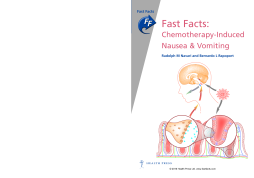
BOOK
Fast Facts: Chemotherapy-Induced Nausea and Vomiting
Rudolph M Navari | Bernardo L Rapoport
(2016)
Additional Information
Book Details
Abstract
Few side effects of cancer treatment are more feared by patients than nausea and vomiting. Failure to control these symptoms on the first day of chemotherapy increases the risk of them occurring on subsequent days and in subsequent cycles of chemotherapy, and can often result in patients refusing further cancer treatment.
Very effective antiemetics are available to prevent this from happening, but do you know how best to use them? Fast Facts: Chemotherapy-Induced Nausea and Vomiting presents the evidence for the clinical agents that can prevent CINV, along with the recommendations for their use in various clinical settings using recently established international guidelines.
Correct administration of prophylactic antiemetics in relation to the emetogenicity of the chemotherapy being given not only improves patients’ quality of life during treatment but also adherence to subsequent cancer treatments, thus improving overall outcomes. This refreshingly readable handbook is therefore a must-read resource for all health professionals in a position to make this kind of a difference.
Table of Contents
| Section Title | Page | Action | Price |
|---|---|---|---|
| Fast Facts: Chemotherapy-Induced Nausea & Vomiting | 1 | ||
| Title page | 2 | ||
| Table of contents | 4 | ||
| List of abbreviations | 6 | ||
| Introduction | 8 | ||
| Chapter 1: Definitions and pathophysiology | 10 | ||
| Chapter 2: Types of CINV and risk factors | 16 | ||
| Chapter 3: Antiemetic agents | 23 | ||
| Chapter 4: Prevention and management of acute | 54 | ||
| Chapter 5: Treatment of breakthrough, refractoryand anticipatory CINV | 70 | ||
| Chapter 6: Prevention and treatment of chemotherapy-induced nausea | 77 | ||
| Chapter 7: Barriers and opportunities inCINV management | 82 | ||
| Index | 88 |
